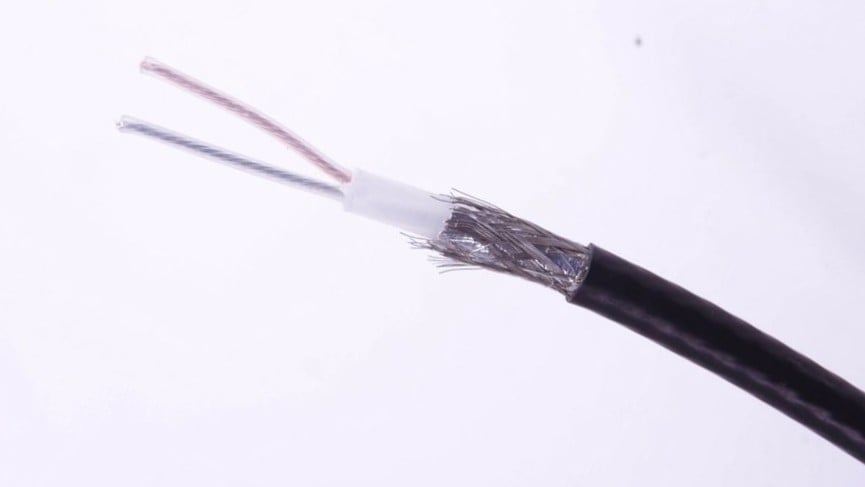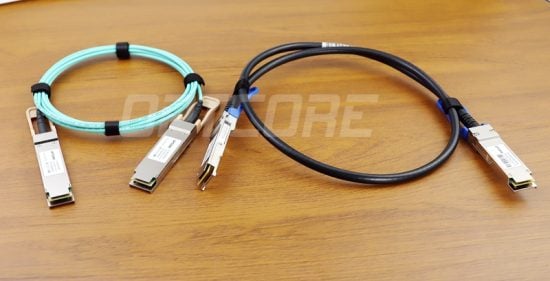Blog, Network Cabling
What is Twinax cable? A Beginner’s Guide
Twinax cable is a two-conductor cable with shielding. As technology evolves, the scenarios where Twinax is used are decreasing. However, Twinax cable still plays a vital role in short-distance, high-speed transmission scenarios, especially as a key part of the Direct Attach Cable (DAC) solution. So, what is Twinax cable? This guide will explain in detail its structure, advantages, and applications.
Table of contents
What is Twinax Cable?
Twinax cable, or Twinaxial cable, consists of ‘twin-‘ and ‘-ax. ‘ ‘Twin-‘ means a pair of similar things, and ‘-ax’ means axis. As the name suggests, the Twinax cable has a twisted pair structure along the cable’s extension direction, i.e., axial, arranged with a pair of similar multi-stranded conductors.
Twinax cable is different from what we often call twisted pairs. Our common twisted pairs comprise two insulated copper wires twisted together to form a pair, like the Ethernet cable, which contains four pairs or eight copper cores.

The main components of the Twinax cable
- Conductor: Twinax cable has two side-by-side center conductors arranged in a twisted pair structure. The conductor material is generally multi-stranded copper wires.
- Insulation layer: the two center conductors are wrapped in dielectric to prevent short circuits and anti-interference
- Shielding: The dielectric outside the conductor layer is made of woven. It plays a role in shielding external electromagnetic interference (EMI). Depending on the interference, different materials or more layers are used.
- Sheath: The outermost layer of the cable protects it, avoids physical damage, and improves its durability. This layer of materials is generally PVC.
Based on this structure, Twinax cable achieves excellent signaling performance.
Comparison of Coaxial cable
Some places may categorize Twinax cable as a Coaxial cable, but there is a clear difference between the two. The main difference between traditional coaxial and Twinax cables is that their center conductor is entirely different.
Twinax cable contains two conductors, while coaxial cable has only one conductor. As a result, the signal transmission modes are different.
Coaxial cable uses single-ended signal transmission, passing through a single conductor from the sending to the receiving end. A reference point, the ground, is required to transmit the signal.

The problem is the uncertain potential difference of the ground, which affects the signal quality. Therefore, the Coaxial cable has poor anti-interference capability.
Twinax cable uses differential signaling, meaning the signal passes through two conductors simultaneously from the transmitter to the receiver. The signals are equal in size and opposite in direction. The two conductors are adjacent and exposed to the same external interference. So, the original signal can be recovered by calculating the offset. Therefore, Twinax cable is more resistant to interference.
Advantages of Twinax Cable
1. High immunity to electromagnetic interference
Twinax cable adopts the differential signal transmission method and has a good shielding layer, so it can effectively resist external electromagnetic interference when transmitting signals.
2. High data transmission rate
Due to its high immunity to interference, the Twinax cable supports high-speed data transmission. It meets the needs of almost all transmission rate gradients, especially in short-distance data transmission scenarios.
3. Cost-effective
Twinax cable performs like fiber optic cable for short-distance data transmission, but its price is much lower, so it is very cost-effective and can effectively save costs.
4. Various Types
Over the years, Twinax cable has developed excellent compatibility. The market has a wealth of connectors and adapters for Twinax cable. However, in modern application scenarios, many equipment do not have a straight Twinax cable connection. So, a connector is needed to form a Direct Attach Cable(DAC). The connector types for Twinax cable are generally SFP+, SFP28, QSFP+, etc. DAC cable is the popular Twinax cabling solution.

If you want to choose the proper DAC for your cabling plan, our products can meet all speed requirements from 1Gbps to 800Gbps. Below are some recommended products. Click here to find more available.
-
Cisco SFP-H1GB-CU1M/2M/3M/5M/7M Compatible 1G SFP DAC Cable
Price range: US$ 6.60 through US$ 18.00 (Excl. VAT) -
Supermicro CBL-NTWK-0417-01 Compatible 1m 40G QSFP+ Cable
US$ 17.00 (Excl. VAT) -
Mellanox MCP1600-C003 Compatible 3m (10ft) 100G QSFP28 Passive Copper Cable
US$ 38.00 (Excl. VAT) -
1m (3ft) Cisco QDD-400-CU1M Compatible 400G QSFP-DD Passive DAC Cable
US$ 109.00 (Excl. VAT)
Applications of Twinax Cable
1. Datacenter
Data centers have a rich demand for short-distance high-speed connectivity, and you can find Twinax cable in data centers of all sizes. DAC cables with SFP+/SFP28/QSFP+ modules can be widely used in data centers for short-distance data transmission, simplify network deployment, and effectively save costs.
2. Network Infrastructure
Twinax cable is also widely used in constructing LAN or enterprise network infrastructure, such as LAN core switches, enterprise HD video display equipment, and switch stacking.
3. CCTV
Twinax cable, such as video surveillance systems, is widely used in CCTV HD video transmission and can provide efficient and economical solutions.
Twinax vs Fiber Cable
As a network connection solution, Twinax is often contrasted with Fiber cable. Fiber optic cable effectively avoids electromagnetic interference and provides ultra-long-distance, high-speed, and stable signal transmission. Over long distances and in high-interference environments, fiber outperforms Twinax. In addition, fiber optic cable is more advanced in technology. It has better scalability, so you do not have to worry about future network or equipment upgrades caused by the inconvenience.

How do you choose between them? In short distances, Twinax cable provides the same high-speed and stable signal transmission as fiber optic cable. Even Twinax may offer lower latency than fiber. Meanwhile, it is more affordable than fiber optic cable, easier to install, and usually has better durability. Suppose you need to wire in an environment with high EMI or wiring over long distances. In that case, you need to consider fiber optics first.
FAQs
1. What types of Twinax cables are available?
Twinax cable is divided into two types when used as a component of a DAC:
- Passive DAC: No additional electronics are required, suitable for short-distance connections up to 7 meters.
- Active DAC: Built-in signal amplifier or equalizer for longer transmission distances. Suitable for connections of 7-15 meters.
2. Is there a limit to the transmission distance of Twinax cables?
Twinax cables are usually suitable for short distances up to 10~15 meters. The maximum distance for passive DACs is usually 7 meters.
3. What are the transmission rates of Twinax cables?
Twinax cables can transmit signals at different speed gradients, from 1Gbps to 400Gbps and up to 800Gbps.
4. Are Twinax cables compatible with all devices?
Twinax cables usually connect to devices via standardized SFP+ or QSFP+ interfaces. These interfaces are widely used in modern networking equipment and, therefore, are generally compatible. However, before choosing, you should check if the device supports the type of connector used.
5. How long do Twinax cables last?
Twinax cables typically have a 5- to 10-year lifespan in regular use.
Conclusion
Twinax cable is becoming the cable of choice for short-distance, high-speed connections due to its high-speed differential signaling, interference immunity, cost-effectiveness, and durability. It is often used to form DAC cables and is widely used in data centers, telecommunication systems, LAN construction, and other scenarios.
Twinax cable’s performance is comparable to fiber optics for short-distance signal transmission, offering better cost performance and durability.
Read more:
- What is DAC Cable? The Definitive Guide
- Passive vs Active DAC cable: How to Choose?
- What is the difference between DAC and AOC Cables
Reference:
- https://www.arista.com/assets/data/pdf/Copper-Faster-Than-Fiber-Brief.pdf
- https://en.wikipedia.org/wiki/Twinaxial_cabling











